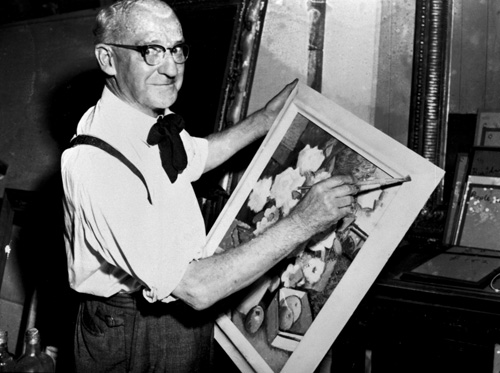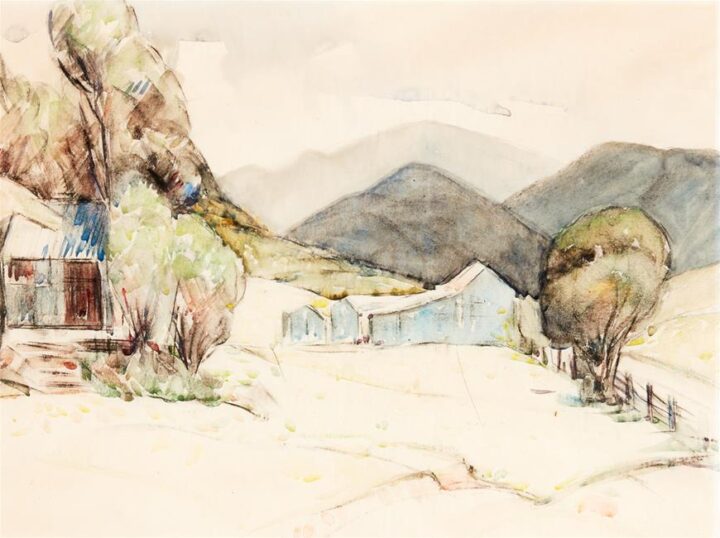John Weeks, born on 8 June 1886 at Sydenham Damerel, Devonshire, England, parents Emma Hooper and husband, William John Weeks. The family emigrated in 1892 to Mangapiko, and later bought a dairy farm at Northcote, Auckland, in 1908.
From that year, Weeks worked as a sign-writer and began night-class study at the Elam School of Art in Auckland under Archibald Nicoll, Alice Whyte and Edward Friström. Among his contemporaries were Francis McCracken, Robert Johnson and Ida Eise (with whom he was to teach at Elam). The family returned to England for a holiday in 1911. Weeks attended some classes at the Sydney Technical College between 1913 and 1915. Thus he was in Australia when war broke out, and after arriving home he signed up in 1917 to the No 3 New Zealand Field Ambulance of the New Zealand Medical Corps. After seeing active service in France and the United Kingdom, he, McCracken and Johnson toured throughout New Zealand an exhibition of some 250 paintings and drawings, dubbed the ‘Soldiers’ Exhibition’.
He went abroad again for an extended period of travel and study, which lasted until 1929 and was to establish the basic patterns of the aesthetic enquiries of his mature career. Initially he made for Edinburgh, sharing a studio that McCracken had already set up. He spent two years at the Royal Scottish Academy of Painting, Sculpture and Architecture and was represented in their exhibitions, receiving what he called a ‘small painting prize’.
In 1925 Weeks left Edinburgh for Paris and enrolled in the academy of the cubist artist André Lhôte the following year. Of particular significance for Weeks’s later work was the attention Lhôte paid to the orchestration of colour, the subtle balancing of tonal arrangements within a composition, and the simplification and disintegration of form. After a lengthy sojourn in the South of France, North Africa and Italy, Weeks returned to his Parisian studies in 1928. Much of his popular reputation derives from the orientalist compositions of his 15 months in Algeria, Tunisia and, principally, Morocco. For the most part these are lightly cubist compositions which, although they are quite strong compositionally, do not involve any rigorous investigation of form.
After his return to New Zealand in 1929 Weeks began the critical phase of his career. In 1930 he took up a relieving teaching position at the Elam School of Art. He was later made a member of the permanent staff, eventually becoming a senior lecturer, and was an extremely energetic, enthusiastic and popular teacher of painting until his retirement in January 1954. Elam in the 1930s was under the leadership of A. J. C. Fisher, who emphasised strongly draughted naturalism. Weeks was the only staff member to offer a different approach. His influence during this time can be found in the work of Frances Hunt, W. S. Wallis and Louise Henderson (who came to Elam to study under him in 1950–51). It is also present in artists whom he did not teach directly – the brothers Charles and John Tole, and Peggy Spicer.
A catastrophic fire that gutted the school’s premises on 15 January 1949 destroyed possibly as many as 200 of Weeks’s paintings and drawings. This event marked, in his view, the nadir of his career and he ceased to be a prolific painter. Ironically, many of his truly significant works may be assumed to date from around or after this period; he often left his paintings undated but the drive to abstraction which is a vital factor in his work is unlikely to date from before 1945.
In the 1930s Weeks was particularly noted for his landscapes. His pictorial architecture and his strong sense of design and composition reveal some interest in analytical cubism. Weeks gradually increased the range of his investigations of colour, texture and, importantly, form. He slowly achieved a simplification of form and structure and a clarity of line in an attempt to discover a distillation of the essence of the subject or object, and moved into an increasingly abstract style of painting. His work of the late 1940s and 1950s influenced local development of modernist abstraction.
In 1955 he was the subject of a retrospective exhibition at the Auckland City Art Gallery, its first solo show dedicated to a New Zealand artist. He was appointed an OBE in 1958 for his services to painting.
John Weeks never married. He was a rather unassuming man, but was also noted for his humour and his sense of the ridiculous. Weeks had been devoted to exploring the limits of his art. His main contributions to New Zealand painting derive from the strength of his compositional structures, his interest in cubist art and his tentative investigations of abstract and formalist compositions.


